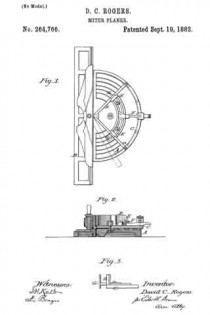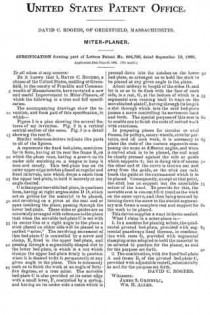No. 264,766 – Miter-Planer (David C. Rogers) (1882)

UNITED STATES PATENT OFFICE.
_________________
DAVID C. ROGERS, OF GREENFIELD, MASSACHUSETTS.
MITER-PLANER.
_________________
SPECIFICATION forming part of Letters Patent No. 264,766, dated September 19, 1882.
Application filed June 27, 1882. (No model.)
_________________
To all whom it may concern:
Be it known that I, DAVID C. ROGERS, a citizen of the United States, residing at Greenfield, in the county of Franklin and Commonwealth of Massachusetts, have invented a new and useful Improvement in Miter-Planers, of which the following is a true and full specification.
The accompanying drawings show the invention, and form part of this specification, in which —
Figure 1 is a plan showing the several features of my invention. Fig. 2 is a vertical central section of the same. Fig. 3 is a detail showing the rest G.
Similar reference-letters indicate like parts in all of the figures.
A represents the fixed bed-plate, semicircular in term, having at its rear the frame B, on which the plane runs, having a groove on its under side matching on a tongue to keep it true and steady. This bed-plate has on its outer upper edge notches placed at regular and fixed intervals, into which drops a catch from the upper bed-plate, to hold it securely at any angle desired.
C is the upper movable bed-plate, in quadrant form, having at right angles sides D D, which act as guides for the material to be planed, and revolving on a pivot at the rear end or apex touching the plane, passing through the lower bed-plate. These sides or guides are so accurately arranged with reference to the plane that when the movable bed-plate C is set with its center-line at a right angle to the plane a stick placed on either side will be planed to a perfect “miter.” The revolving movement of this bed-plate C is controlled by a screw and clamp, E, fixed in the upper bed-plate, and passing through a segmentally-shaped slot in the lower bed-plate, in which is a nut which clamps the upper bed-plate firmly in position when it is desired to fix it permanently at any given angle to the plane. This is commonly such as to finish the work at an angle of forty-five degrees, or a true miter. The movable bed-plate C is also provided at its outer edge with a small lever, F, controlled by a spring, and having on its under side a catch which is pressed down into the notches on the lower bed-plate, so arranged as to hold the stick to be planed at any given angle to the plane.
About midway in length of the sides D, and let in so as to be flush with the face of each side, is a rest, G, at the bottom of which is a segmental arm running back in ways on the movable bed-plate C, having through its length a slot through which into the said bed-plate passes a screw controlling its movement back and forth. The special purpose of this rest is to enable one to finish the ends of curved work with exactness.
In preparing pieces for circular or oval frames, for pulleys, emery-wheels, circular patterns, and all such work, it is necessary to plane the ends of the various segments composing the same at different angles, and when a curved stick is to be planed, the end must be closely pressed against the side or guide which supports it; but in doing this of course the other end of the curve is thrown out and away from the guide, as the stick can only touch the guide at the extreme end which is to be planed. Consequently, except at that point, the stick has no support but the unreliable action of the hand. To provide for this, the movable rest is run out till it touches the work on the outer curve, and then being secured by turning down the screw in the slotted segmentary arm forms a complete rest and support for the work to be planed.
This device supplies a want hitherto needed.
What I claim in a miter-plane is —
1. In a machine for planing miters, the quadrantal pivoted bed-plate, provided with segmental guardways fixed thereon, in combination with rests G, provided with segmental clamping-arms adapted to hold the material to be mitered in position for the planer, as and for the purpose set forth.
2. The combination, with the tired bed-plate A and frame B, of the pivoted bed-plate C, provided with adjustable rests G, substantially as and for the purpose set forth.
DAVID C. ROGERS.
Witnesses:
JAMES S. GRINNELL,
WM. H. ALLEN.


